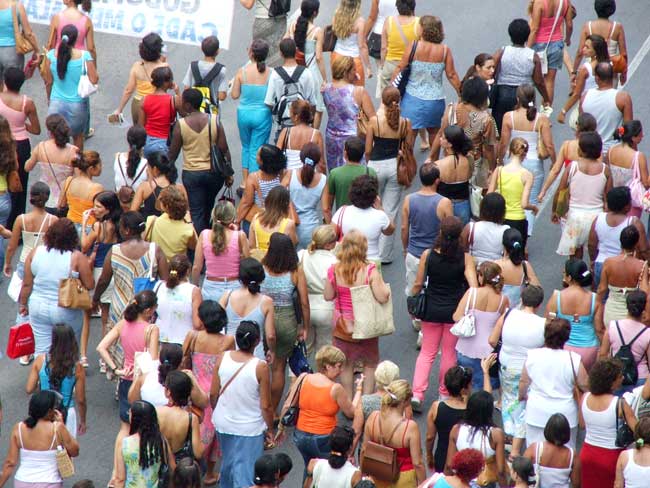Little-Known Disorder: People Can't Recognize Faces

Some people can't remember names. Thomas Grüter can't hold onto a face. Instead, this medical doctor, who has what is called prosopagnosia, or face blindness, uses several tricks to avoid an embarrassing social gaffe.
"The first thing is I think, 'Who can I expect where?'" Grüter told LiveScience. For example, if a person is standing in Dr. Smith's office, it's safe to assume it's Dr. Smith. Grüter has also become an expert at recognizing voices.
By intentionally hiding this "inability," Grüter and others could go under the radar of scientists or doctors in the field. In a perspectives essay in the April 23 issue of the journal Science, Grüter and co-author Claus-Christian Carbon, both of the University of Bamberg, Markusplatz, in Germany, suggest several reasons this and other cognitive disorders get missed.
"I am convinced that there are many cognitive peculiarities and disorders we don't know about yet," Grüter told LiveScience. In fact, they think many cognitive disorders still await discovery.
Face blindness
Before 2005, the face blindness disorder was only known from individual case reports and it was thought to be extremely rare. New research by Grüter and his wife, both medical doctors, suggested 2.5 percent of the general population in Germany have the disorder. "So it's millions of people suffering from that, but it wasn't known," Grüter said, adding that he thinks it's reasonable the same would hold across Europe.
Culture can play a role. For instance, in a primitive, mostly illiterate society, a cognitive disorder would only get noticed if it, say, kept a person from becoming an expert archer, the researchers say.
Get the world’s most fascinating discoveries delivered straight to your inbox.
Even in literate societies, conditions differ and so can get missed depending on which version of the disorder a person has.
"Chinese dyslexia is different from European dyslexia, because Chinese characters are totally different and you need different cognitive skills to read them," Grüter said. "You may be dyslexic for Chinese characters but wouldn't have any trouble reading European characters."
Even tests meant to capture individuals with cognitive disorders can miss the mark. For instance, in the Benton Facial Recognition Test (BFRT), used by cognitive scientists to fish out face blindness, individuals are asked to compare a face photo on the left with three face photos on the right and then indicate which of the three is identical to the one on the left. The problem is subjects commonly rely on matching features such as hairline and eyebrows rather than recognizing the facial configuration, Grüter said.
Bottom line: Normal scores on some cognitive tests might not reflect reality.
Spotting subtle cues
In reality, the subtle cues that someone can't recognize faces or is dyslexic might only show up if you were looking for certain behaviors in everyday life situations, not on a test. That's because often subtasks are involved with cognitive processes. For those with a hereditary type of color blindness called color agnosia, they might instead compare surface texture of one object with a known one to compensate for the impaired ability. Similarly relevant subtasks might be used for voice agnosia.
Since these people were born with the impairment, they've "never known normal cognition," the researchers write. And so it might even be difficult for them to describe their condition to a doctor. If someone were to complain to a doctor that he or she had trouble recognizing people, the doctor might just chalk it off to a patient who can't remember names – a very common memory problem.
When Grüter and his wife, both medical doctors, interviewed 700 individuals in Germany (17 of which turned out to have face blindness), they used interviews and behavioral questions to find those with the cognitive impairment.
For instance, they might ask a subject to imagine being a receptionist at a hotel – a situation in which it's vital you accurately recognize faces – those with face blindness had several tricks up their sleeve. One individual said she had "dozens of strategies."
"She said, 'most of them come in pairs, that makes it a lot easier. You just have to remember what kind of pair,'" Grüter recalled.
Why it matters
But if these individuals aren't suffering, why point out their deficits?
"They're functioning but they still kind of suffer," Grüter explained. "A lot of people we talked to said, 'I thought I was just distracted all the time; I just couldn't remember the people.'" ("They say people; they mean faces," he added.)
In addition, by studying these ailments scientists can learn a lot more about the brain – an organ that still befuddles even the most intelligent. Perhaps the brains of individuals with certain cognitive deficits operate differently in order to compensate, causing "the neural networks to develop and connect in specifically different ways and lead to typical behavioral changes," the researchers write.
As for how Grüter found out he had face blindness, his wife had seen a TV program on PBS about a guy with a severe form of face blindness. "And my wife said, 'This could be you,' and I said, 'No it can't,'" Grüter recalled. "In a way, it was. I wasn't really suffering from it, but she was right."
- Top 10 Controversial Psychiatric Disorders
- 10 Things You Didn't Know About the Brain
- Top 10 Spooky Sleep Disorders
Jeanna Bryner is managing editor of Scientific American. Previously she was editor in chief of Live Science and, prior to that, an editor at Scholastic's Science World magazine. Bryner has an English degree from Salisbury University, a master's degree in biogeochemistry and environmental sciences from the University of Maryland and a graduate science journalism degree from New York University. She has worked as a biologist in Florida, where she monitored wetlands and did field surveys for endangered species, including the gorgeous Florida Scrub Jay. She also received an ocean sciences journalism fellowship from the Woods Hole Oceanographic Institution. She is a firm believer that science is for everyone and that just about everything can be viewed through the lens of science.


